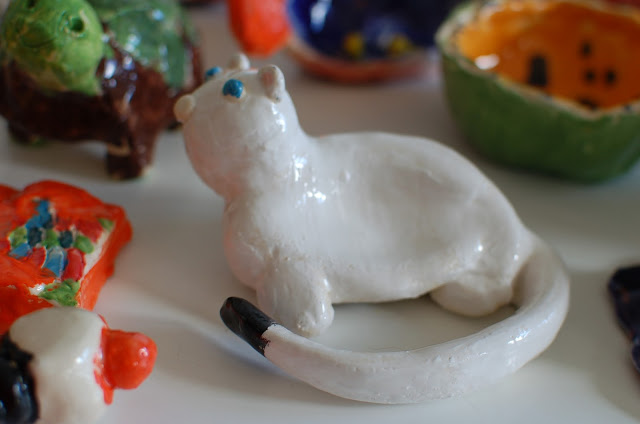I decided on OWLS as I love them and I wanted an easy form that my 5 year old's could do. I choose water balloons as they are small and the children wouldn't loose interest. I decided to add some rice in the bottom of them so they could be used as shakers and it meant the owl "rocks" if you tap him.
We are still in the middle of making these in my art classes yet I decided to do a "Part One" post now so that the other lovely people on the ecourse could learn the process. Someone asked me the other day why I have this blog if it doesn't earn me money. I do it as I want to contribute back to the wonderful blog world and share my ideas, successes and failures. I am so grateful to all those people who share their ideas and post great tutorials, hopefully I can give a little back.....
This lesson is probably best for Grade 2 to 4.
What you need:
- Newspaper (two pieces per child)
- White Paper Strips
- Paper Mache Paste (see note below)
- Water Balloons
- Paint (either tempura or acrylic)
- Mod Podge
- Rice
- Wooden Skewer
- Funnel
- Plastic cups or bowls with children's names on them (if more than one child)
- Blow up the balloons (I found this easiest using a balloon pump).
- Pass out the newspaper to the children and ask them to tear it into strips. I asked them to do this task as I worked out earlier it took about 2 pieces of newspaper to cover the balloon 4 times with strips and this ensured they actually did 4 coats (they had to use up all their newspaper).
- Demonstrate how to use the paste and strips (we just used fingers to smear paste on balloon and then over each strip)
- Cover entire balloon leaving a small hole in the top with the knot poking out
- Once each child has completed 4 coats we left them to dry in plastic cups with their name written on it
- Once dry (for us the following week) ask the children to pop their balloons using the wooden skewer.
- Insert a funnel into the top of the balloon shape and add rice to bottom (approx 3-4 tablespoons)
- Hand out white paper strips and paste and ask them to cover the hole and add at least one layer of white paper to their shape.
- :Leave to dry in marked cups
- Once dry (for us the following week) ask the children to paint their shapes as owls. You may wish to do this over two weeks to allow one week to paint the base coat and another week to add details. I also created a simple step by step sheet on how to paint an owl which I will attach to Part 2 (we have computer issues at the moment).
- Paint on a layer of Mod Podge before they take them home (optional).
Here is my teacher example again....
NOTES:
I did this lesson with children aged 5 to 10 years. Some of the younger children's shapes did tend to collapse a bit when adding the white paper. I think this was due to them not distributing the paper evenly over their form in the first week so some places were rather thin and got soggy.
I couldn't find Elmers Paper Mache Paste in Australia. Actually I had problems finding any paper mache paste. In the end I used a homemade recipe using cornflour (cornstarch) and water. It did end up gel like and didn't smell bad so all good so far...I gave it to the children warm and they loved this!
This lesson does take 3 weeks. I run classes for 1.5hrs so I always had another art activity as well. Each step took approximately half an hour so you could easily do this in three 45 min lessons with something for early finishers (we also had yarn weaving and finger knitting going on for early finishers, watch out for my post on this coming up soon....).
Feel free to ask any questions..
Cheers
Fiona








.JPG)

























